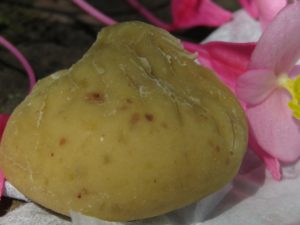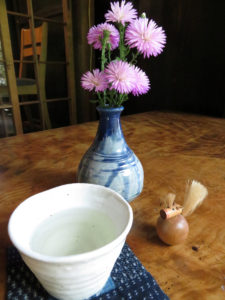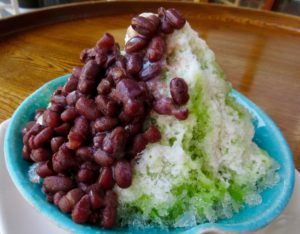
By Amy Chavez
The Nakasendo was an Edo Period (1603-1868) road used for travel between the capital of Edo (Tokyo) and Kyoto, the former capital. The 69 post towns along the way provided accommodation and services to daimyo and their entourages, who passed through on their sankin kōtai biennial visits to the Tokugawa shogunate.
I’m set to hike the most popular and picturesque section, the lower Kiso Road, from the post town of Magome-juku in Gifu Prefecture to the next, Tsumago-juku in Nagano Prefecture. Over this 7-kilometer stretch, I aim to get some insight into the local palates and what travelers may have eaten along the path when it was Japan’s most-traveled highway.
Though it’s well known that the poet Matsuo Basho wandered the Nakasendo, it is Magome’s native son, Toson Shimazaki, who is most inextricably linked to this section of the Kiso Road. The Shimazaki family served as the village headmen, taking care of the feudal lords as well as pilgrims such as Basho and others who passed through. 
In Magome-juku, the atmosphere is thick with the ubiety of Shimazaki (1872-1943), who is one of Japan’s most celebrated authors. The controversial figure (who fled to France after impregnating his niece) can perhaps be sensed in the stickiness of the local specialty, gohei mochi (grilled rice on a stick topped with sweet miso), while his softer side as progenitor of modern Japanese poetry is palpable in the marriage of textures and flavors of the various provincial chestnut confections.
Arriving in late afternoon, I stopped at the acclaimed Cafe Kappe along the steep main street inlaid with large flat stones. Inside, I found the proprietor sitting at one of the tables peeling a mound of chestnuts. “Chestnut parfaits!” she said with a smile. I ordered one and noshed on it while gazing at Mount Ena (2,191 meters) straight out the window.
I had booked into Eishoji, a Zen temple (formerly Manpukuji Temple in Shimazaki’s book “Before the Dawn”). Temple cats lounged around decoratively in the garden.
I had not come for the visuals, however, but rather the victuals: the shōjin ryōri (vegetarian food for Buddhist priests) for which the temple is known.
In a formal tatami room facing the garden a dozen bowls and plates of food were waiting for me. I immediately felt tense when I noticed that the scroll overshadowing me from the tokonoma (decorative alcove) bore the kanji for “patience.”

The priest’s wife explained the dishes: ganmadoki (fried tofu made with shaved lotus root and potato), a bowl of fresh tofu in a light sauce, a square of sesame tofu with a drip of wasabi on top, steamed green vegetables, boiled pumpkin artfully arranged in a blue side dish, a sweet red plum, eggplant boiled to a sheen and graced with miso sauce, cucumber salad, soba noodles, a generous bowl of raw pink ginger and locally harvested rice. Plus tea, of course. She politely bowed, left the room, and I dug in, completely ignoring the ancient scroll’s advice.

After a visit to the Shimazaki family grave in the morning, I left the temple’s moss-laced pathways ringing with bird-song and continued up the steep Magome hill seeking treats for the trail. I procured individually wrapped kurikinton candied chestnuts from a confectionery run by a toothsome dowager who said she had lived in this village her whole life.
At the top of the hill, I glanced back at Mount Ena and the Mino Valley before padding across the ishitatami, the inlaid stones that mark the ancient Kiso Road.
The well-preserved trail is studded with tea houses, rest spots, toilets and water at regular intervals. After 5.5 km, the route crosses into Nagano Prefecture and the Magome Pass (801 meters), which winds down into Otsumago.
At times the route follows a stream, hopscotching from one side to the other via wooden pedestrian bridges. The two waterfalls are not-to-be-missed, and it is at the bottom of the Odaki waterfall that I enjoyed my kurikinton delicacies.

Golden rice fields begging to be harvested and whispering fūrin wind chimes dangling in front of row houses greeted me as I descended into the hamlet of Tsumago-juku, where women were hand-making straw coned hats from hinoki (Japanese cypress). Small shops purveyed souvenirs and wooden toys.
Rows of soba shops that previously fed the legions of attendants to the daimyo during the Edo Period now serve their replacements: tourists who stream in by the hundreds via bus.
Suddenly, a tall man with a friendly smile hailed me from the open doors of a latticed wooden house: “Oyaki!” I bought one of the vegetable-filled hot buns and another stuffed with walnut paste. Mr. Hara has been selling oyaki from this shop since returning to his hometown 26 years ago.

Having arrived at my destination, I sampled the Jurokudai Kuroemon sake at a quiet shop called Shirokiya facing the old road, and imbibed with my companion, a small toy horse made from sakura cherry wood. Perhaps the sake invigorated me because after this short rest I yearned to go a little further that day. I hiked another 5 km to Nagiso Station in Midono.
I’m glad I did, because I discovered the perfect way to end a hot day on the Nakasendo: with a matcha azuki shaved ice desert at Cafe Izumiya, across from the station.
This article originally appeared in The Japan Times as part of a series called “Gourmet Trails.“
Feature Photo by Frank Zhang on Unsplash
